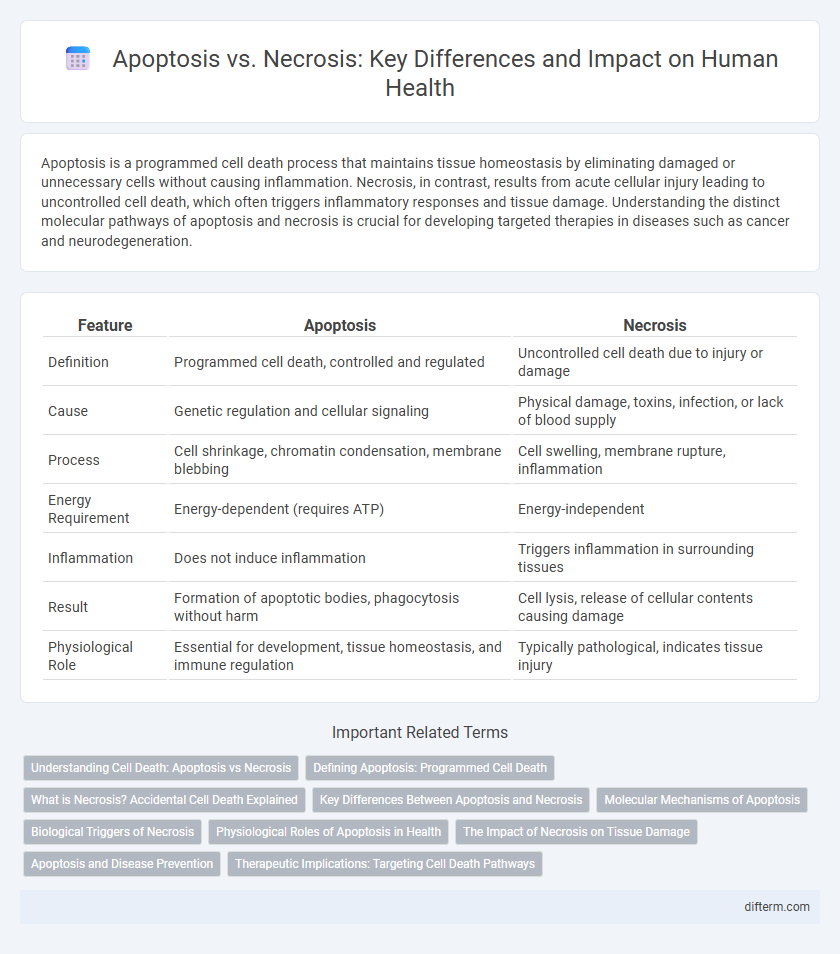Apoptosis is a programmed cell death process that maintains tissue homeostasis by eliminating damaged or unnecessary cells without causing inflammation. Necrosis, in contrast, results from acute cellular injury leading to uncontrolled cell death, which often triggers inflammatory responses and tissue damage. Understanding the distinct molecular pathways of apoptosis and necrosis is crucial for developing targeted therapies in diseases such as cancer and neurodegeneration.
Table of Comparison
| Feature | Apoptosis | Necrosis |
|---|---|---|
| Definition | Programmed cell death, controlled and regulated | Uncontrolled cell death due to injury or damage |
| Cause | Genetic regulation and cellular signaling | Physical damage, toxins, infection, or lack of blood supply |
| Process | Cell shrinkage, chromatin condensation, membrane blebbing | Cell swelling, membrane rupture, inflammation |
| Energy Requirement | Energy-dependent (requires ATP) | Energy-independent |
| Inflammation | Does not induce inflammation | Triggers inflammation in surrounding tissues |
| Result | Formation of apoptotic bodies, phagocytosis without harm | Cell lysis, release of cellular contents causing damage |
| Physiological Role | Essential for development, tissue homeostasis, and immune regulation | Typically pathological, indicates tissue injury |
Understanding Cell Death: Apoptosis vs Necrosis
Apoptosis is a programmed cell death process characterized by cell shrinkage, chromatin condensation, and membrane blebbing, playing a vital role in tissue development and homeostasis. Necrosis, in contrast, is an uncontrolled cell death resulting from injury or infection, causing cell swelling, membrane rupture, and inflammation. Understanding the molecular pathways and triggers of apoptosis versus necrosis is crucial for developing targeted therapies in diseases such as cancer, neurodegeneration, and ischemic injuries.
Defining Apoptosis: Programmed Cell Death
Apoptosis is a form of programmed cell death characterized by specific morphological and biochemical events, including cell shrinkage, chromatin condensation, and DNA fragmentation. This regulated process plays a critical role in maintaining tissue homeostasis and eliminating damaged or potentially harmful cells without triggering inflammation. Unlike necrosis, apoptosis involves energy-dependent signaling pathways and is essential for normal development, immune system function, and prevention of cancer.
What is Necrosis? Accidental Cell Death Explained
Necrosis is a form of accidental cell death resulting from external injury or trauma that causes irreversible cellular damage. Unlike apoptosis, necrosis triggers inflammation as damaged cells swell, rupture, and release their contents into surrounding tissues. This uncontrolled cell death often leads to tissue damage, impaired function, and contributes to pathological conditions such as infections, toxins, or ischemia.
Key Differences Between Apoptosis and Necrosis
Apoptosis is a regulated cell death process characterized by cell shrinkage, chromatin condensation, and DNA fragmentation, essential for maintaining tissue homeostasis. Necrosis, in contrast, results from acute cellular injury leading to cell swelling, membrane rupture, and inflammation. The key differences lie in apoptosis being a programmed, energy-dependent event without eliciting inflammation, whereas necrosis is a passive, uncontrolled process causing cellular damage and inflammatory responses.
Molecular Mechanisms of Apoptosis
Apoptosis is a programmed cell death process driven by tightly regulated molecular mechanisms, including the activation of caspases, mitochondrial cytochrome c release, and DNA fragmentation. Key proteins such as Bcl-2 family members regulate mitochondrial outer membrane permeabilization, initiating the intrinsic apoptotic pathway. Unlike necrosis, apoptosis maintains membrane integrity and avoids inflammatory responses by orchestrated cellular dismantling.
Biological Triggers of Necrosis
Necrosis occurs primarily due to external factors such as trauma, infection, toxins, or ischemia, leading to uncontrolled cell death and inflammation. Cellular energy depletion and loss of membrane integrity trigger necrosis by causing osmotic imbalances and enzyme leakage. Unlike apoptosis, necrosis lacks a programmed biological pathway and results in cellular swelling and rupture, releasing intracellular contents into the extracellular space.
Physiological Roles of Apoptosis in Health
Apoptosis plays a crucial physiological role in maintaining cellular homeostasis by eliminating damaged or unnecessary cells without triggering inflammation, thus supporting tissue development and immune function. This programmed cell death process shapes organs during embryogenesis and removes potentially cancerous cells, preventing tumor formation. Efficient apoptosis ensures the balance between cell proliferation and cell death, vital for sustaining healthy tissue regeneration and preventing autoimmune disorders.
The Impact of Necrosis on Tissue Damage
Necrosis causes uncontrolled cell death that results in the release of cellular contents, triggering inflammation and further tissue damage. The progression of necrosis disrupts the structural integrity of affected tissues, often leading to impaired organ function. Unlike apoptosis, which is a regulated process, necrosis exacerbates injury by promoting swelling, rupture, and immune system activation.
Apoptosis and Disease Prevention
Apoptosis, also known as programmed cell death, plays a critical role in maintaining cellular homeostasis by eliminating damaged or potentially cancerous cells before they proliferate. This controlled cellular process prevents chronic inflammation and suppresses tumor formation, contributing significantly to disease prevention. Dysregulation of apoptosis can lead to a variety of pathological conditions, including autoimmune disorders and cancer.
Therapeutic Implications: Targeting Cell Death Pathways
Therapeutic strategies targeting apoptosis pathways enable controlled elimination of damaged cells, reducing inflammation and promoting tissue regeneration, while necrosis inhibition prevents uncontrolled cell death that triggers immune responses and exacerbates disease. Drugs modulating key apoptotic proteins like caspases and Bcl-2 family members demonstrate promise in cancer treatment and neurodegenerative disorders. Understanding the distinct molecular mechanisms behind apoptosis and necrosis guides development of precision therapies aimed at restoring cellular homeostasis and minimizing pathological cell loss.
Apoptosis vs Necrosis Infographic

 difterm.com
difterm.com